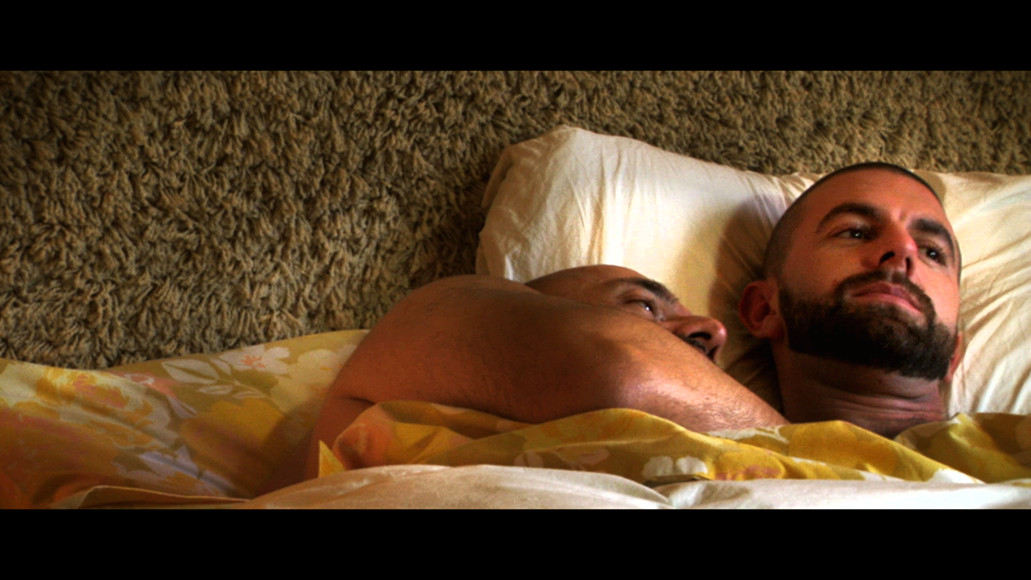 Dani Marti, Time Is the Fire in Which We Burn, 2009
Dani Marti, Time Is the Fire in Which We Burn, 2009The power of Dani Marti’s work is also its puzzle. He has maintained a practice of seemingly disparate threads between woven sculpture on the one hand and videos documenting sexual exchanges with strangers on the other. The two very different strands of his practice are connected for Marti as acts of portraiture. A key work from when he was based in Glasgow, Time Is the Fire in Which We Burn exists as a video encounter (2009) and as his reading of the video’s subject in the form of several sculptural wall works (created between 2009 and 2013). The latter are made from woven copper and silver scourers—cleaning products as metaphors of mortality and time, risk and infection. Woven together they pulsate like fleshy sores or anuses, abstractions of bodily interiority.
Intimacy Porn is the only way I can think to describe his videos. For Time Is the Fire in Which We Burn, Marti sets up a camera and tripod to document his conversation with John, a self-described rent boy and porn performer recovering from crystal meth addiction and a failed three-way relationship. John is a handsome and charismatic raconteur. He explains his drug addiction as a philosophised pursuit of happiness—a ‘suspended animation’ of time—using a scene from the 1994 film Star Trek Generations when Dr Tolian Soran (played by Malcolm McDowell) says to Captain Picard (Patrick Stewart): ‘They say time is the fire in which we burn’. What John doesn’t realise is that the line comes from Delmore Schwartz’s 1937 poem ‘Calmly We Walk through This April’s Day’.
Tightly framed in closeup, Marti’s camera lingers on both their faces, John’s especially. The otherwise cold scrutiny of such voyeurism is warmed up by Marti’s care, attentiveness and deep listening.
As John recounts how he once fisted a well-paying psychiatrist, it becomes apparent that this video (clocking in at just over an hour) is pillow talk and Marti himself is both shrink and john. The video, a document of their erotic therapy session.
Marti’s video practice borrows from the codes and questionable ethics of observational documentary. Naming the exchange established between artist and subject as Intimacy Porn foregrounds the arousal of sexual desire for a spectator of images trading in so-called reality. Watching Marti with John is like being at the end of their bed, positioned polyamorously as a viewer hanging on their every word like foreplay for an excised sex act. Deep into its duration after what seems like hours of chatter they have sex, but the post-coital clean-up is all we see.
The camcorder aesthetic, typical of the time, is a reminder of how video technologies changed so much during this era. Cheap and easier to use than what came before, they gave rise to a proliferation of video art at the same time as amateur porn on the internet decimated the production, distribution and consumption habits preferred by porn’s dominant studio system. Marti’s videos are radical because they complicate existing portraiture or documentary conventions by approaching the erotics of amateur porn. Having met John on Gaydar at a time when online hook-up apps and websites were emerging concurrently with social media platforms, Marti harnesses the voyeuristic power of digital media to construct an ethics of care.
For a moment, that care extends to me—now libidinously overinvested as viewer—as I wonder what became of John, assuming the worst based on his vulnerability and appetite for risk. Out of curiosity I join the dots with a Facebook search, finding John still lives in Glasgow, now married and content, if the veracity of his profile pic is anything to trust. Within minutes I am googling John’s old videos on Pornhub when his former porn name, as if by magic, materialises. Fleshing out Marti’s portrait of John with data easily gleaned online, I become challenged by my own voyeurism. How I so wilfully stalked a new object of desire as an exercise in art criticism is surely the endgame to what Marti set in motion the minute he hit record on that camera all those years ago.
Essay for Queer Readings of the Monash University Collection
Published by Monash University Museum of Art in 2021.